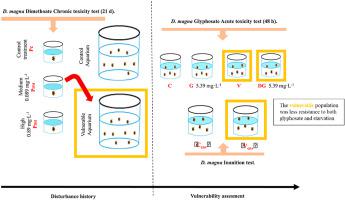Chemosphere ( IF 8.8 ) Pub Date : 2020-09-24 , DOI: 10.1016/j.chemosphere.2020.128373 María Eugenia López-Valcárcel , Gema Parra , Ana del Arco

|
Since aquatic ecosystems receive runoff of most anthropogenic pollutants, risk assessment tools and protocols have been developed in order to protect them. However, most ecological risk assessments focus on the study of single species exposed to a single chemical, overlooking the environmental reality of multiple chemical exposures and stresses over generations. To advance in realistic predictions of population and community changes, the environmental disturbance history should be considered. The aim of this study was to evaluate how environmental disturbance history (continuous expected sublethal exposure to one chemical for several generations) determines populations’ responses to another stressors. The experiments were performed with Daphnia magna as model organisms. To create a disturbance history, dimethoate was used as first stressor at two different concentrations: medium (0.089 mg·L-1) and high (0.89 mg·L-1). The population exposed to medium concentration (“vulnerable population”) showed no differences from the control population in the selected parameters (body size and reproductive success). Our interest in the vulnerable population was to determine whether, after a first stressor, the detected non-effect hides a population impairment, which might undermine populations’ responses to future stressors. After 4 generations under dimethoate exposure, the vulnerable D. magna population was exposed to a second chemical stressor (glyphosate) and an environmental stressor (food scarcity) as compared to control. The vulnerable population showed both less resistance to glyphosate and less resistance to starvation, corroborating the hypothesis that a disturbance history of continuous expected sublethal chemical exposures undermines populations’ responses to further chemical and environmental stressors.
中文翻译:

环境骚扰历史破坏了人口应对人为和环境压力因素的反应
由于水生生态系统会吸收大多数人为污染物,因此已经开发了风险评估工具和规程以保护它们。但是,大多数生态风险评估都侧重于研究暴露于一种化学物质的单个物种,而忽略了多种化学物质暴露和历代压力的环境现实。为了对人口和社区变化进行现实的预测,应该考虑环境扰动的历史。这项研究的目的是评估环境干扰历史(连续几代人预期接触一种化学物质的亚致死作用)如何决定种群对另一种应激源的反应。实验是用大水蚤进行的作为模型生物。为了创建骚扰史,乐果被用作两个不同浓度的第一应激源:中等(0.089 mg·L-1)和高(0.89 mg·L-1)。处于中等浓度的人群(“弱势人群”)在选择的参数(体型和生殖成功)方面与对照人群没有差异。我们对弱势群体的兴趣在于确定在第一个压力源之后,所检测到的非影响是否掩盖了人口损害,这可能会破坏人口对未来压力源的反应。在乐果暴露下4代后,脆弱的D. magna与对照组相比,该人群暴露于第二种化学应激源(草甘膦)和环境应激源(食物短缺)。脆弱人群对草甘膦的抗药性较弱,对饥饿的抗药性也较弱,从而证实了以下假设:连续预期的亚致死性化学暴露的干扰史破坏了人们对其他化学和环境应激源的反应。



























 京公网安备 11010802027423号
京公网安备 11010802027423号